Abstract
In this work, we analyze the combinatorial properties of the category of augmented semi-simplicial sets. We consider various monoidal structures induced by the co-product, the product, and the join operator in this category. In addition, we also consider monoidal structures on augmented sequences of integers induced by the sum and product of integers and by the join of augmented sequences. The cardinal functor that associates to each finite set X its cardinal induces the sequential cardinal that associates to each augmented semi-simplicial finite set X an augmented sequence of non-negative integers. We prove that the sequential cardinal functor is monoidal for the corresponding monoidal structures. This allows us to easily calculate the number of simplices of cones and suspensions of an augmented semi-simplicial set as well as other augmented semi-simplicial sets which are built by joins. In this way, the monoidal structures of the augmented sequences of numbers may be thought of as an algebraization of the augmented semi-simplicial sets that allows us to do a simpler study of the combinatorics of the augmented semi-simplicial finite sets.
1. Introduction
The main objectives of this work are framed in the study of the combinatorics of augmented semi-simplicial sets. We can highlight, among others, the following targets:
- The study of some properties about the combinatorics of the faces in semi-simplicial complexes (polyhedra)
- The analysis of the numerical sequences (sequential cardinals) arising from the combinatorial structure of semi-simplicial complexes.
- The development of some semi-simplicial constructions and the search for methods for counting the number of their faces.
- The study of relationships between such semi-simplicial constructions and their associated numerical sequences.
We are considering two kind of mathematical objects:
- (i)
- Augmented semi-simplicial and co-semi-simplicial objects,
- (ii)
- Augmented integer sequences and matrices.
As far as simplicial objects are concerned, we have focused on what we have called -sets, or augmented semi-simplicial sets. Using this category has its advantages and drawbacks. On the one hand, we point out that the significant information is given in the combinatorics of non-degenerated simplices so that fewer data are necessary for their coding. Nevertheless, the use of degenerated simplices would allow one to represent simplicially a greater number of continuous maps. Another feature in our study is considering augmented semi-simplicial objects. This slight modification makes both the structures and formulas we are using symmetric and much more reduced, so that it helps facilitate their computation. For notions related with semi-simplicial sets, we refer the reader to [1,2,3,4,5] and for a study of the realization of semi-simplicial sets [6]. For category models related with homotopy theory of simplicial sets and topological spaces, see [7].
As basic combinatorial elements, we are considering the following ones:
(bc) Binomial coefficients ():
which give the number of strictly increasing maps from the ordered set with q elements to the ordered set of p elements . These numbers occur as coefficients in Newton’s binomial formula
and the coefficients in Pascal’s triangle
which can also represented by the matrix
In order to write this work, we have examined some results about binomial numbers in the following references: [8,9,10,11,12].
(gc) Numbers associated with certain geometric configurations: Consider integers and . The d-dimensional n-th triangular number is inductively defined as follows:
These numbers are contained in the family of regular polytope numbers, see [13].
When you consider other combinatorial subjects on semi-simplicial sets, there are many connections with the standard families of sequences and matrices of numbers as Stirling [14], and chain-power-set numbers [15]. For more information about these types of numbers, we refer the reader to [16,17]. Nevertheless, in order to write a shorter paper, we have focused on analyzing some relations between semi-simplicial finite sets and binomial and triangular numbers.
In this work, we study a new version of join construction for augmented semi-simplicial sets which has similar properties to the one developed by P. Ehlers and T. Porter [18] for augmented simplicial sets. However, one important novelty of our work is that we endow the category of augmented semi-simplicial finite sets with a categorical semi-ring structure (i.e., a bimonoidal category structure) that admits a right action of augmented co-semi-simplicial objects in the category of semi-simplicial finite sets. This structural enrichment permits an interesting study of the combinatorial properties of the join operations and constructions obtained by actions. The categorical semi-rings used in this paper are also called bimonoidal categories [19]. Recent results on these categorical structures can be seen in [20,21]. Our paper gives interesting new applications of these structures to the study of combinatorial problems of augmented semi-simplicial finite sets.
In the algebraic context, we consider categories of augmented sequences of integers with a categorical ring structure that admits actions of certain augmented matrices. This action is defined by using the inverse matrix of the matrix associated with binomial transformations.
The sequential cardinal functor, denoted by , applies a semi-simplicial finite set X to the sequence , where denotes the set of n-simplices of X and is its cardinal. The main results of this paper ensure, on the one hand, that the sequential cardinal functor is a homomorphism of categorical semi-rings (Theorem 4) and, on the other hand, that the sequential cardinal functor is compatible with action operators (Theorem 5, Corollary 6). These results allows us to easily count the number of simplices of a semi-simplicial finite set built through join and action operations.
A (augmented) simplicial complex is a family of subsets of a finite set F, , such that, if and (), then . We note that a (augmented) simplicial complex has a canonical structure of (augmented) semi-simplicial set , where , (). The f-vector of a (augmented) simplicial complex () of a (augmented) simplicial complex is given by . Therefore, the notion of f-vector is obtained as a restriction of sequential cardinal (given in the present work) to augmented simplicial complexes. For a study of the main properties of f-vectors and their associated h-vectors, we refer the reader to [22] and for recent advances on the study of f-vectors: [23,24,25]. In our work, instead of studying realization problems, we prove new results for semi-simplicial finite sets by taking the sequential cardinal and obtaining new properties related to join and action operations on augmented semi-simplicial finite sets.
At the end of the work, we give a concrete example of calculations associated with constructions given by joins and actions induced by the dunce cap. These calculations are done by using the inverse matrix of augmented binomial numbers and the augmented matrix of triangular numbers (Corollaries 12 and 13).
2. Categorical Preliminaries: Presheaves and Monoidal Categories
2.1. Extension of a Small Category to a Cocomplete One Using Presheaves
We will denote as the category of sets.
Given a small category , we can consider its opposite category . Then, the usual functor category has as objects functors and as arrows all natural transformations between such functors. The category is usually called category of presheaves on .
For a given object c in , we can consider , the presheaf on defined as the contravariant Hom-functor . This construction gives rise to the well-known Yoneda embedding
By an embedding in this setting, we mean a full and faithful functor. Any presheaf which is isomorphic to a presheaf of the form is called representable. The Yoneda lemma is well known, asserting that, for any presheaf, X, there exists a bijection between the natural transformations and the elements of :
Associated with , we have the so-called category of elements of X, denoted by . Its objects are all pairs , where c is an object in and ; a morphism in consists of a morphism in such that . Observe that we have a projection functor
The proof of the following theorem can be found in [26].
Theorem 1.
Let be a functor from a small category to a cocomplete category . Then, the functor given by
admits a left adjoint functor , defined for each presheaf X as
The functor preserves colimits and makes commutative the following diagram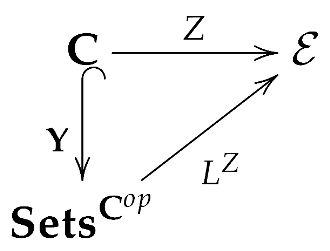

In other words, is an extension of Z that preserves colimits. Moreover is, up to natural isomorphism, the only extension of Z preserving all colimits.
Remark 1.
Observe that, actually, we have a functor:
As a particular case, taking and the Yoneda embedding, we have that the functor is naturally isomorphic to the identity functor (by the Yoneda lemma). Therefore, must be also naturally isomorphic to the identity functor so we obtain the following corollary:
Corollary 1.
Every presheaf X on is, up to natural isomorphism, a colimit of representable presheaves:
We also observe that, as a consequence of Theorem 1 above with , one has certain suitable induced functors. Such functors will receive the name of action functors:
Definition 1.
The action functors are the following:
- 1.
- 2.
Given and , the object is said to be the (right) action of Y on X. Similarly, is said to be the (right) action of Z on Y.
Remark 2.
If and , then it follows that
This formula inspires the name given: “action functors”.
2.2. Monoidal Categories
In this subsection, we include the definition of monoidal category and that of functors between monoidal categories. For a more complete study on the notions and properties related to monoidal categories, we recommend reading the volumes by Niles Johnson and Donald Yau [19].
Definition 2.
A monoidal category is a category equipped with:
- (1)
- a functor out of the product category of with itself, called the tensor product,
- (2)
- an object I called the unit object or tensor unit, and
- (3)
- three natural isomorphisms:The associator α, with componentsThe left unitor λ and the right unitor ρ, with components
such that the following diagrams are commutative (coherence diagrams):
Pentagon identity:

Triangle identity:

By a strict monoidal category, we mean a monoidal category in which the natural isomorphisms are identities. In this case, the pentagon and triangle diagrams commute automatically.
Definition 3.
A symmetric monoidal category is a monoidal category having a natural transformation s (it is necessarily a natural isomorphism) called the braiding, with components , making commutative the following kind of diagram: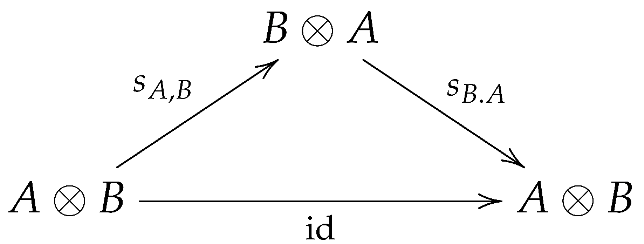

That is, Moreover, we also demand that the braiding and the associator obey the hexagon identity:

If, in addition, the monoidal category is strict, we will say that is a strict symmetric monoidal category.
Definition 4.
A functor between monoidal categories is said to be 2-monoidal if it is equipped with a natural isomorphism Φ with components , such that the following diagram commutes for any objects in :

We say that F is -monoidal (or just monoidal in classical terminology) if, in addition, there exists an isomorphism satisfying that the following diagrams are commutative for any object A in :

Finally, a 2-monoidal (or -monoidal) functor between symmetric monoidal categories is said to be symmetric if it satisfies the following commutative diagram, for any objects in :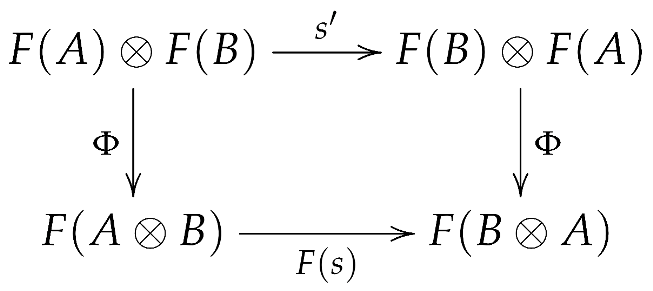

Remark 3.
In this paper, we use the terminology of categorical semi-ring for the notion of a symmetric bimonoidal category given in Definition 2.1.1 in [27], see also [19,28]. Moreover, some of the examples we are studying are a particular case that has the structure of a distributive symmetric monoidal category given in Definition 2.3.1 in [19]. For general information about monoidal categories, we refer the reader to [29,30,31]. Some interesting relations between monoidal categories and classifying spaces are given in [32] and, for new advances in the study of monoidal categories, you can see [33,34,35].
In the following paragraphs, we include the notion of a free strict monoidal category generated by a category.
For any given category , the free monoidal category over , denoted as , is given as follows:
- Its objects are finite sequences of objects in . The empty sequence is also considered, and it is taken as the unit object I.
- Consider two objects and in . If , then a morphism consists of a sequence where is a morphism in , for all If , then there are no morphisms between and .
The tensor product of two finite sequences and is defined as their concatenation
Analogously, the tensor product of two morphisms in is given by the corresponding concatenation of morphisms in One can straightforwardly check that is a strict monoidal category. In addition, observe that we have a canonical functor
which is, actually, a full embedding.
Any monoidal category that is isomorphic (in the monoidal sense) to a free monoidal category will be also called free monoidal category.
The free monoidal category has the following universal property:
Proposition 1.
Let be a functor between a category and a strict monoidal category . Then, there exists a -monoidal functor, which is unique up to isomorphism, making commutative the following triangle: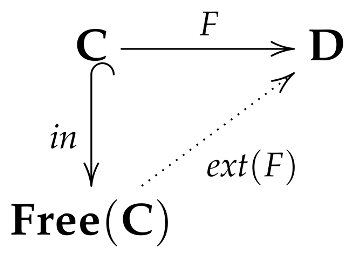

Proof.
The functor is defined as and , for every object A in . In addition, for every object of length 2. Now, if is defined for sequences of objects of length , then we may inductively define
F is similarly defined for morphisms. The rest of the proof is lengthy but straightforward. □
Remark 4.
In the context of monoidal categories, it is interesting to take into account the following result, whose proof can be found in [36]:
MacLane’s Theorem.Given a monoidal category , there exist a strict monoidal category together with a monoidal equivalence . Similarly, given a braided (resp. symmetric) monoidal category , there exist a strict braided (resp. symmetric) monoidal category with a braided (resp. symmetric) monoidal equivalence .
2.3. Extending Monoidal Structures to Presheaves
Consider a small monoidal category. We will see that the monoidal structure on can be extended to the category of presheaves . Indeed, first of all, observe that we have a diagram given by two rectangles
 where is the natural functor induced by the product of sets: ; and the functor is the colimit-preserving extension of the composite functor given after using Theorem 1. Composing these two rectangles and denoting as the composite , we obtain a commutative diagram:
where is the natural functor induced by the product of sets: ; and the functor is the colimit-preserving extension of the composite functor given after using Theorem 1. Composing these two rectangles and denoting as the composite , we obtain a commutative diagram:
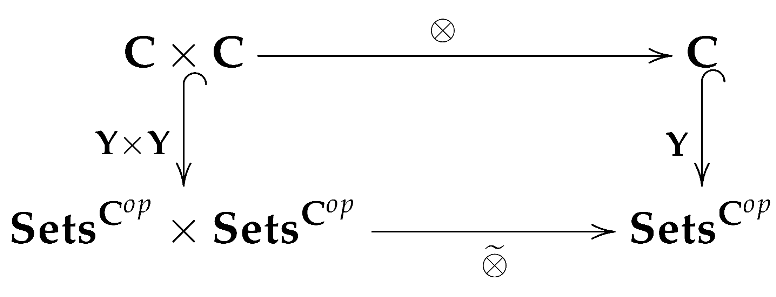
 where is the natural functor induced by the product of sets: ; and the functor is the colimit-preserving extension of the composite functor given after using Theorem 1. Composing these two rectangles and denoting as the composite , we obtain a commutative diagram:
where is the natural functor induced by the product of sets: ; and the functor is the colimit-preserving extension of the composite functor given after using Theorem 1. Composing these two rectangles and denoting as the composite , we obtain a commutative diagram:

Moreover, we can also consider the Yoneda object
Theorem 2.
is a monoidal category and the Yoneda embedding, , is -monoidal.
Proof.
In order to prove that is a monoidal category one has just to take into account that any presheaf on is naturally isomorphic to a colimit of representable presheaves (see Corollary 1) and that is monoidal. We leave the details to the reader. The Yoneda embedding is -monoidal by the above commutative diagram relating ⊗ and moreover, by definition. □
Now, we want to extend Theorem 1 for the special case when we consider monoidal structures. In order to do this, we need some previous results. Assume and are small categories and , functors. Then, the existence of a natural isomorphism is well known:
By how the functor is defined, it is straightforward to check that this property also holds when we have functors and :
Indeed, for any object in the product category , we have
For more results related to Theorem 2, we refer the reader to [37,38].
Taking into account this latter natural isomorphism, we have the following result:
Proposition 2.
Consider , small categories and functors , . Then, there exists a natural isomorphism
Proof.
Considering the previous comments and taking into account that the functor preserves colimits, we have:
□
Remember that, by using Theorem 1 when , for any given functor , there exists a colimit preserving functor such that When Z is -monoidal, we can say more about
Theorem 3.
Let be a -monoidal functor. Then, the colimit-preserving functor , which makes commutative the diagram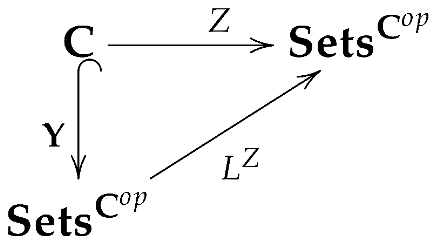 is -monoidal. Moreover, up to isomorphism, it is the unique colimit preserving functor making this diagram commutative.
is -monoidal. Moreover, up to isomorphism, it is the unique colimit preserving functor making this diagram commutative.
 is -monoidal. Moreover, up to isomorphism, it is the unique colimit preserving functor making this diagram commutative.
is -monoidal. Moreover, up to isomorphism, it is the unique colimit preserving functor making this diagram commutative.Proof.
Consider X and Y presheaves over We know by Corollary 1 that, up to natural isomorphism, any presheaf is the colimit of representable presheaves. Therefore, we can suppose that
Therefore,
Moreover, Checking that the coherence diagrams are indeed commutative is lengthy but straightforward. □
Remark 5.
Observe that Theorem 3 above can be easily generalized for any -monoidal functor , where is a monoidal cocomplete category satisfying the additional condition that, for any two diagrams , , there exists a natural isomorphism
We have an extension functor that is -monoidal. Moreover, up to isomorphism, is the unique colimit preserving functor making the following diagram commutative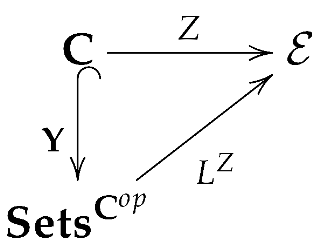

3. Augmented Semi-Simplicial Sets
In this section, we will deal with the combinatorial objects we are interested in for this work, the augmented semi-simplicial sets. As we are about to see, the category of augmented semi-simplicial sets is defined as the category of presheaves on a certain small category.
3.1. Basic Notions and Results
Consider the small category whose objects are non-empty totally ordered sets for and whose morphisms are the strictly increasing maps We can add the empty set to this category together with all the strictly increasing maps. The new augmented category will be denoted by .
We can consider and , the presheaf categories on and on , respectively. Taking , , and considering the notation for given in Definition 1 we have the following action functors:
We obviously have the corresponding Yoneda embeddings:
For any object in , we will denote as the representable presheaf
Analogously, we will consider the notation
Definition 5.
Any presheaf on
will be called augmented semi-simplicial set or -set. Analogously, any presheaf on , , will be called augmented co-semi-simplicial set or -set.
We point out that giving an augmented semi-simplicial set is equivalent to giving a collection of sets together with a collection of set maps ( and ) satisfying
Moreover, giving an arrow in (i.e., a natural transformation) is equivalent to giving a collection of set maps such that
for and
There is a similar description for the category of augmented co-semi-simplicial sets by just reversing the arrows in the above representation.
In this work, we also consider the subcategory of finite sets and the corresponding category of presheaves .
A semi-simplicial set is said to have finite dimension if there is such that for every . Given a non-empty finite dimensional semi-simplicial set X, we denote
For the empty semi-simplicial set, we set
The subcategory of finite dimensional semi-simplicial sets is denoted by . A semi-simplicial set is said to be finite if it has finite dimension and for every , is a finite set. The subcategory of finite semi-simplicial sets is denoted by .
3.2. Products and Coproducts
The usual product × and coproduct ⊔ of sets induce, in a natural way, two symmetric monoidal category structures in with unit objects the singleton 1 and the empty set respectively.
Given , we have the product and the coproduct , which are straightforwardly induced by the corresponding coproduct and product in . For any given set , we can consider the constant -set, , defined as , for all In particular, we are interested in the constant -sets, and . It is plain to check the following natural isomorphisms:
Note that the subcategory is closed by finite sums and products and that are finite sets.
Therefore, we obtain the following result:
Proposition 3.
The sum and the product induce the following structures:
- (i)
- and are symmetric monoidal categories.
- (ii)
- and are symmetric monoidal categories.
- (iii)
- the canonical inclusionsare -monoidal functors.
Moreover, we also have the natural isomorphism relating the two tensor products:
We also observe that, for every , one has the evaluation functor
that preserves the (co)product, and the units. In particular, we can consider -monoidal functors
Remark 6.
It is obvious that . Therefore, is a symmetric monoidal category. On the other hand, , indicating that is not a monoidal category. However, taking the full subcategory , one has that is a monoidal category.
3.3. Join, Cone, and Suspension Constructions in Augmented Semi-Simplicial Sets
Now, we will consider special constructions in -sets, or augmented semi-simplicial sets. We first observe that the small category has a symmetric monoidal category structure induced by the coproduct (actually, the ordinal sum)
having as a unit object.
We define the join of -sets as the natural extension of this ordinal sum to (see Section 2.3). We obtain the join functor
It is immediate to check that, for any pair of -sets, , their join is given as
where p and q run over the integers that are greater than or equal to In particular, , , and so on.
Moreover, the operators of are naturally defined from the operators and of X and Y, respectively. The definition of ⊞ on morphisms is straightforward.
For any pair , we have that the functors
preserve colimits. Furthermore, if , then there exist canonical natural isomorphisms
Corollary 2.
The category , together with the join functor ⊞, the unit object , and the natural isomorphisms above, is a symmetric monoidal category. Moreover, the Yoneda embedding
is -monoidal.
Proof.
This is a direct consequence of Theorem 2. □
Remark 7.
Note that is a monoidal subcategory of , which is a monoidal subcategory of . If , one has that:
Corollary 3.
Given , the following isomorphism holds true
We have the left-cone functor and the right-cone functor :
These functors make the following squares commutative:


Corollary 4.
and satisfy
for all
Now, consider the augmented 0-sphere
where denotes the identity of
Then, as a particular case of the join construction, and similarly to the case of the cones, we have the augmented left-suspension functor and the augmented right-suspension functor (see Figure 1, Figure 2):
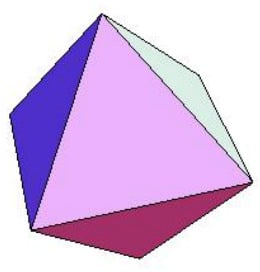
Figure 1.
The join .
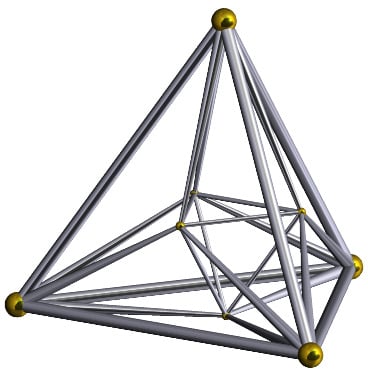
Figure 2.
The join .
3.4. Action Functors and Triangle Products
We can consider and , the presheaf categories on and , respectively. Remember that taking , , and, considering the notation given in Definition 1, we have the action functors:
We observe that the cylinder and the barycentric subdivision of a semi-simplicial set can be obtained by using action functors and some particular co-semi-simplical objects .
Remark 8.
If denotes the full subcategory of whose objects are and , then it is plain to check that, up to isomorphism, together with the coproduct (ordinal sum) is isomorphic to the free monoidal category over . This fact will be crucial for the next reasoning.
Let be any category. Then, in order to consider a functor , one has just to give a morphism in . Moreover, if is monoidal, one can take the particular case . The following result is a consequence of Remark 8 and Proposition 1.
Corollary 5.
Let be a monoidal category and the functor given by a morphism . Then, there exists a -monoidal functor extending F: which is given by , and . Moreover, is, up to isomorphism, the unique -monoidal extension of
which is given by , and . Moreover, is, up to isomorphism, the unique -monoidal extension of
 which is given by , and . Moreover, is, up to isomorphism, the unique -monoidal extension of
which is given by , and . Moreover, is, up to isomorphism, the unique -monoidal extension of Definition 6.
Let be a monoidal category, a morphism in and the functor induced by f. Then, the -monoidal extension is said to be the co-semi-simplicial extension of f and it is denoted by ). When there is a unique morphism f from I to X, we can use the notation , deleting f in , and we say the is the co-semi-simplicial extension of X.
Definition 7.
Let be a functor. If , then the object is said to be the tilde-triangle product of X and Z. If is a morphism in , then is said to be the f-triangle product of X and Y. When there is a unique morphism f from to Y, is simply denoted as , and it is said to be the triangle product of X and Y.
The following result is a direct consequence of Theorem 3. We recall again that we are using the particular notation for the construction :
Corollary 6.
Let be a -monoidal functor. Then, the colimit-preserving functor , which makes commutative the diagram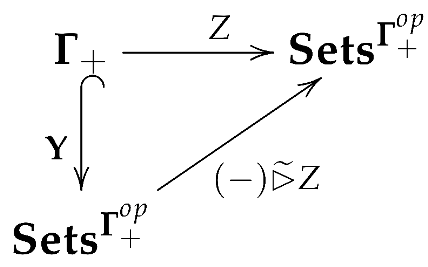

is -monoidal. In particular, for all , we have
Moreover, up to isomorphism, it is the unique colimit preserving functor making this diagram commutative.
Remark 9.
The monoidal category is a monoidal subcategoy of which is, in turn, a monoidal subcategoy of . Observe that:
- (i)
- if is a -monoidal functor, then we obtain a -monoidal functor.
- (ii)
- if is a -monoidal functor, then we also obtain that is a -monoidal functor.
4. Augmented Integer Sequences and Matrices
Once we have analyzed some nice categorical and combinatorial properties of the category of augmented semi-simplicial sets, we study the second kind of mathematical objects in this work: augmented integer sequences (and matrices). The connection between these two different worlds will become clear in the next section through the cardinal functor.
4.1. The Categories , , and Some Functor Categories
We know that the set of integer numbers admits the structure of a discrete category. However, we can also consider it as a groupoid where the cardinal and the unique morphism from n to m can be denoted as , for every pair of integers . The sum of integers can be easily extended to a functor
Taking + as a tensor product and 0 as a unit object, it is immediate to check that has the structure of a strict symmetric monoidal category and also of a strict categorical group.
Remark 10.
By a categorical group, we mean a monoidal category which is also a groupoid and there exists a functor together with natural isomorphisms m, n and with components , satisfying that, for every object A, the following diagram is commutative:

Roughly speaking, every object is invertible, up to natural isomorphism, with respect to the tensor product. In addition, if is strict as a monoidal category and the natural isomorphisms m, n are identities, then we have that is a strict categorical group.
It is plain to check that, given any small category , the functor category has an induced strict symmetric monoidal category structure (in addition, it is a strict symmetric categorical group). We shall consider the full subcategory of consisting of functors such that there exists a finite set of objects satisfying that for all .
Now, if denotes that the set of natural numbers (0 is also included as a natural number), take the discrete category . This category can be considered as a subcategory of both and through the (inclusion) functor . Observe that the category is self-dual, that is, .
Given a functor with , we will call dimension of c the integer
and, for , we take
Taking into account that is a discrete category, we have that the Yoneda embedding associated with (note that this functor is a restriction of the Yoneda functor ) induces, by applying the cardinal operator to the corresponding hom-sets, a functor satisfying , for all Here, denotes the Kronecker delta
Therefore, and for all . This way, we actually have a functor
In the following result, we may think that the monoidal category is Thus, we will keep the notation + for the tensor product and 0 for the unit.
Proposition 4.
Let be a strict symmetric categorical group. If is any functor, then there exists, up to natural isomorphism, a unique -monoidal functor
making the following diagram commutative: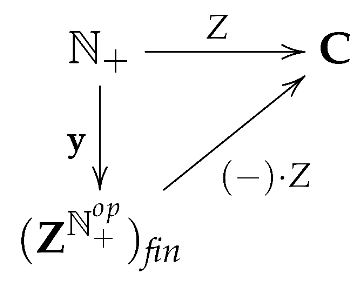

Proof.
Given any integer and any object , we can define, in a natural way, another object (similarly ) given from the tensor product + in and the existence of the inverse object. Namely,
Now, consider a functor . If we denote and , then we define
which is well defined since it is a finite sum. Note that, if , we have
In addition, is accordingly defined for morphisms so that we obtain a functor. A straightforward inspection proves that such a functor makes the diagram commutative, and it is -monoidal. Moreover, it is unique up to natural isomorphism, satisfying these properties. □
Remark 11.
We point out that the functor
is always -monoidal regardless of whether the functor Z is -monoidal or not. This means that is the free (strict) symmetric categorical group in the discrete category .
Remark 12.
We have a dual version of Proposition 4. If we take a functor , then there exists, up to natural isomorphism, a unique -monoidal functor , which is an extension of Z.
Definition 8.
An augmented integer sequence is a functor
More generally, given any category , we call augmented sequence in any functor . We will denote an augmented sequence a by means of a row matrix
However, in some cases, this row matrix will be denoted by (using commas):
Analogously, an augmented integer co-sequence is a functor More generally, for a given category , an augmented co-sequence in is a functor . We will denote an augmented co-sequence b by means of a column matrix
or , where T denotes the transposition operator.
Remark 13.
Observe that, in the definition above, we have given two different names to the same mathematical object (remember that is self-dual). Nevertheless, associated with each name, we are using a different notation, which will be crucial when we consider matrix products later on.
Definition 9.
An augmented integer matrix is a functor . In general, given a category , an augmented matrix with entries in is just a functor . An augmented matrix U will be denoted by its usual form
Remark 14.
For any given categories , there are canonical isomorphisms and . Therefore, we have induced isomorphisms
As a consequence, any augmented matrix may be considered as an object in any of the categories above.
Definition 10.
Let be a strict symmetric categorical group. The following functors will be called dot-products:
Remark 15.
If is a strict symmetric categorical group and we consider the subcategory of those functors satisfying that there is with for ( is analogously defined), then we also have natural dot-products:
In this case, the functors , are also -monoidal.
4.2. Multiplication (Dot-Product) of Augmented Matrices
Now, we see how matrix multiplication is induced by the categorical group structure. Consider ; if and is any functor, then we have that they are of the form
Therefore, is well defined and we have an induced bifunctor
Similarly, we have a bifunctor
Taking into account the transposition isomorphism we have that the composition induced by the identity on the first variable and the transposition on the second variable induces the scalar (or inner) product:
Namely, if and , then
It is easy to check that one has the following canonical extended bifunctors of the dot-product:
4.3. Join of Numerical Augmented Sequences: Cone and Suspension
We note that has the structure of a ring , which is induced by the ring structure of by pointwise operation. That is, for all , their sum and product are given as
For , we will also use the notation .
However, we may consider a new symmetric monoidal structure on . This is given by the join product:
Definition 11.
The join product of , denoted as , is given by the following formula:
In this case, the unit object is given as where is the Kronecker delta. In this work, for , will denote the augmented sequence given by .
Proposition 5.
The category equipped with the join product ⊞ and the unit object has the structure of a strict symmetric monoidal category. Moreover, the induced functor is -monoidal.
Remark 16.
It is an obvious fact that is a monoidal subcategory of . If , then, by our definition of dimension, one has:
If are fixed, then we easily obtain functors
given by and , respectively.
Now, for each , we define an operator in the category (actually, a functor)
as follows: given and ,
- If , then ,
- If , then:
Definition 12.
For a given , we define , the shifting of b, by the formula for all . We may also see it as the matrix
This construction naturally gives rise to a functor
which satisfies, in a natural way, the commutativity given in the next result.
Proposition 6.
The diagram

is commutative. In other words, given , we have the equalities
Now, we present an interesting construction: the cone of a sequence.
Definition 13.
We define the cone of as the sequence defined as . That is to say,
Manifestly, we obtain the cone functor Taking into account the results above, the next consequence is straightforward to check.
Proposition 7.
Consider . Then, the cone functor is related to the join and the dot product through the following formula:
Remark 17.
Iterating the cone functor and bearing in mind the identity , which is given in the result above, we obtain that (). This way, is completely determined by the sequence of matrices , , , …
It is also simple to check that the cone functor has an inverse functor
where
is the inverse of .
Consequently, the inverse of the cone functor may be expressed by the equation
where and .
Next, we define the Euler q-characteristic of any .
Definition 14.
Consider a sequence and a rational number . Then, if , the Euler q-characteristic of c is the rational number defined as
When , we take .
Remark 18.
If and , then we obtain , the sum of all elements of
When , we have the Euler characteristic:
and, for , we obtain
Remark 19.
We have that for . Now, if denotes the full subcategory of consisting of those sequences with Euler characteristics equal to zero, then the (restricted) cone functor is an isomorphism. Its inverse functor
can be given for by the expressions (see the formula above for the inverse )
since .
Note that a finite augmented sequence not satisfying the Euler characteristic condition is the cone of an infinite-dimensional augmented sequence. For instance,
where the first sequence contains negative integers.
We are also interested in the suspension of a sequence.
Definition 15.
The suspension of a sequence c is the sequence defined as . In other words,
There is an obvious induced suspension functor , which is straightforwardly related to the join and the dot product.
Proposition 8.
Consider . Then, the suspension functor is related to the join and the dot product through the formula
Remark 20.
Taking the iteration of the suspension functor and the relation given in the result above, we obtain that (). That is, as in the case of the cone, the iteration of the suspension is completely determined by the sequence of matrices , , , …
The suspension functor has an inverse functor
where
Hence, one has
for any and .
Remark 21.
We want to mention that for any . Consider the full subcategory of consisting of those sequences having a Euler -characteristic equal to zero. Then, the (restricted) suspension functor is an isomorphism. Taking into account that , for , the functor
can also be expressed as
for
Like the case of the cone functor, a finite augmented sequence not satisfying a Euler -characteristic condition is the suspension of an infinite-dimensional augmented sequence. For instance,
where the first sequence contains negative integers.
4.4. Actions of Augmented Matrices on Augmented Sequences of Integers
To finish this section, we consider actions of sequences and matrices. We first establish the augmented binomial matrix defined as
and its inverse matrix given as
Definition 16.
Given a sequence and a matrix , the action of B on a is defined by the formula
The resulting sequence is also said to be the tilde-triangle product of a and B. This construction gives rise to an action functor
We point out that we also have the identity
Let denote the full subcategory of the discrete category whose objects are and 0. Then, it is plain to check that, up to isomorphism, together with the coproduct
is isomorphic to the free monoidal category over .
If is any category, then, in order to consider a functor , it is only needed to give two objects in . Moreover, if is monoidal, one can consider the particular case . The following result is a direct consequence of Proposition 1.
Corollary 7.
Let be a monoidal category and . Then, there exists a -monoidal functor extending , :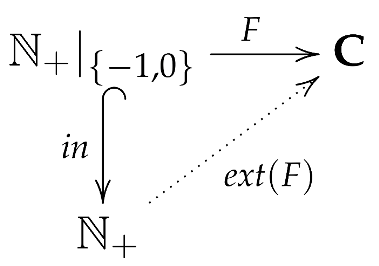 which is given by , for , and . Moreover, is, up to isomorphism, the unique -monoidal extension of
which is given by , for , and . Moreover, is, up to isomorphism, the unique -monoidal extension of
 which is given by , for , and . Moreover, is, up to isomorphism, the unique -monoidal extension of
which is given by , for , and . Moreover, is, up to isomorphism, the unique -monoidal extension of Specializing and , we obtain the notion of augmented matrix extension of b:
Definition 17.
Consider the functor , . The -monoidal extension is said to be the augmented matrix extension of b, and it is denoted as
Finally, the notion of augmented matrix extension will raise the one of the triangle product:
Definition 18.
Given sequences and ,
is said to be the triangle product of a and b.
Note that .
5. Comparing Monoidal Categories Arising from -Sets and Numerical Sequences
Now, we are ready to compare the category of augmented semi-simplicial finite sets and the category of augmented integer sequences. The key point is the sequential cardinal functor which applies every finite augmented semi-simplicial set to the sequence constituted by the cardinal of the set of n-simplices. This sequential cardinal functor preserves the corresponding monoidal structures. Moreover, as we will see, it preserves certain categorical semi-ring structures.
5.1. The Monoidal Categories and as Well as and
Recall that is the category of finite sets and maps between them. Given any functor , we may consider the diagram
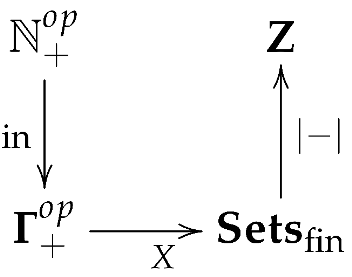 where in denotes the inclusion functor and denotes the functor giving the cardinal of any finite set.
where in denotes the inclusion functor and denotes the functor giving the cardinal of any finite set.
 where in denotes the inclusion functor and denotes the functor giving the cardinal of any finite set.
where in denotes the inclusion functor and denotes the functor giving the cardinal of any finite set.Definition 19.
The sequential cardinal of a - finite set, is defined as the augmented sequence:
given by the composite . To put it another way,
We observe that there is an induced functor where, for morphisms , is defined as ; that is, .
On the one hand, in Section 3.2, we have seen that and are monoidal categories. On the other hand, in Section 4.3, we have seen that the ring structure induces the ring structure and the monoidal structures , .
Proposition 9.
The functor preserves the monoidal structures induced by coproducts and products:
Proof.
It is straightforward to check the identities:
which are left to the reader. □
Definition 20.
Associated with the -sets, and , where is the identity of , we consider the sequential cardinals:
We note that and
Remark 22.
For every , the sequential cardinal applied to is given by the binomial coefficients:
5.2. The Monoidal Categories and
In this subsection, we consider , which is a monoidal subcategory of . The sequential cardinal functor preserves the monoidal structure:
Theorem 4.
The sequential cardinal functor
is -monoidal, that is, the following holds true:
for all .
Proof.
From the join definition, we have that
where and Therefore, the equality follows taking into account Definition 11. Namely:
□
The cone functors, for semi-simplicial sets and for augmented sequences, are related through the sequential cardinal functor:
Proposition 10.
The following diagrams are commutative:

Moreover, as , we have (the -fold join of with itself).
Proof.
By the definition of a left-cone functor, we have that
Here, we have used Theorem 4 and Proposition 7. The commutativity of the right diagram is analogously verified. The rest of the proof is straightforwardly taking into account the formula and that □
Definition 21.
Consider a finite semi-simplicial set and a rational number . Then, the Euler q-characteristic of X is the rational number defined for as
and
Corollary 8.
If is, up to isomorphism, the (left or right) cone of some then and for such that , .
Proof.
If , then and therefore (see Remark 19). Note also that and . By Remark 17, . □
Note that the cardinal functor induces a canonical functor where is the composite
Definition 22.
The augmented Pascal matrix is defined as the augmented co-sequence given by the composite:
Note that (given in Section 4.4).
Corollary 9.
The functor
carries the Yoneda augmented semi-cosimplicial set , matricially represented as
to the augmented Pascal matrix, where each row is the cone of the previous one.
Remark 23.
Observe that iterating the cone construction to generates, in a natural way, the well-known Pascal triangle:
The suspension functors for semi-simplicial sets and for augmented sequences of integers are related as follows:
Proposition 11.
The following diagrams are commutative:

Moreover, .
Below we have obtained, coming from , the iteration of the suspension construction:
For each , we may consider an operator , defined as
Note that . Therefore, one has:
which is obtained by removing the first row and the principal diagonal in the augmented Pascal matrix.
For the suspension functor, the analogous of Corollary 8 is the following result:
Corollary 10.
Let X be a finite semi-simplicial set (). If X is the suspension of some then and for such that , .
5.3. The Categorical Semi-Rings and
As we have earlier commented, in this paper, by a categorical semi-ring, we will mean a symmetric bimonoidal category. This is just a category equipped with two symmetric monoidal category structures:
- the additive structure
- the multiplicative structure
together with
- (i)
- natural isomorphisms , which are called left multiplicative zero and right multiplicative zero, respectively.
- (ii)
- natural monomorphismscalled the left distributivity morphism and the right distributivity morphism, respectively.
This structure must satisfy Laplaza’s axioms (see Definition 2.1.1 in [27] and [19,28]).
A functor between categorical semi-rings (or symmetric bimonoidal categories) is said to be a functor of categorical semi-rings if it is a symmetric bimonoidal functor, that is,
- F is a symmetric -monoidal functor (recall from Definition 4) from the additive structure of to the additive structure of .
- F is a symmetric -monoidal functor from the multiplicative structure of to the multiplicative structure of .
These are required to make the following two diagrams in commutative for all objects :
Multiplicative zero: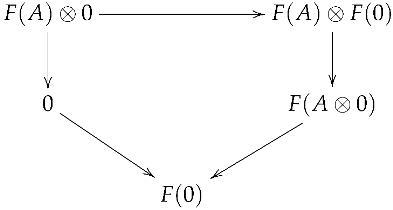

Distributivity:

The next result gives a functor of categorical semi-rings:
Proposition 12.
The sequential cardinal functor
is a functor of categorical semi-rings such that the following diagram is commutative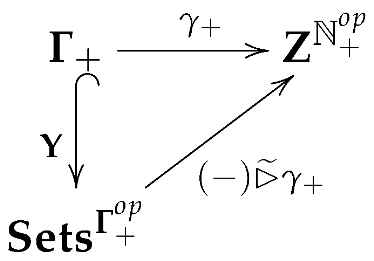

Proof.
Consider the monoidal category . The finite sequences , determine a unique morphism, , in . Applying Proposition 1, we obtain a (symmetric) -monoidal functor given, up to isomorphism, by 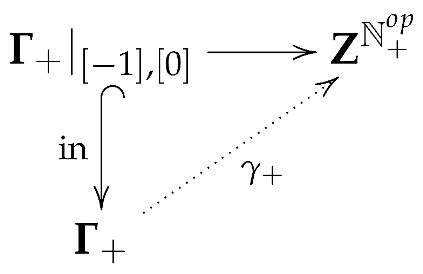

Taking into account Remark 5, one has a commutative diagram
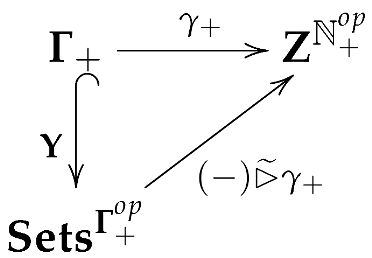 where is a -monoidal functor.
where is a -monoidal functor.
 where is a -monoidal functor.
where is a -monoidal functor.Since, by Theorem 4, we also have the (symmetric) -monoidal functor
such that , it follows that . As it preserves coproducts it is, actually, a functor of categorical semi-rings:
We leave the rest of the proof to the reader. □
5.4. Comparing Actions and Triangle Products
To finish this section, we establish an important result asserting that, under mild restrictions, the sequential cardinal functor carries the action to the triangle product. We need a previous definition.
Definition 23.
A functor is said to be regular if is injective (on each dimension) for every morphism φ in . We shall denote as the full subcategory of consisting of regular functors.
Theorem 5.
The following diagram is commutative:

In other words, if and , then
Moreover, if we specialize , then
Proof.
If is regular, then we consider
From this construction, one can easily check that
where . Therefore, we have the following product of matrices:
Finally, from the definition of , we obtain
□
6. Example: Functors and Triangle-Products Induced by the Dunce Cap
To finish our study, we provide a striking result coming from the example of the dunce cap.
6.1. Augmented Triangular Numbers
Definition 24.
Let be an integer. For , we consider , the n-th triangular number of dimension d, inductively defined as
We refer the reader to Theorem 1.3 in [13] for a proof of the following result (, ):
We complete the matrix of triangular numbers for dimension −1 to obtain the augmented matrix of triangular numbers
Note that, for , , one has that . Then, it is easy to check that, for , , we also have:
We give some values of the matrix tri:
6.2. Triangular Numbers and Co-Semi-Simplicial Object Induced by the Dunce Cap
Associated with the dunce cap , which is the final object in the category , we can consider the unique augmented semi-simplicial map
Corollary 11.
Let the functor induced by the map . Then, there exists an extension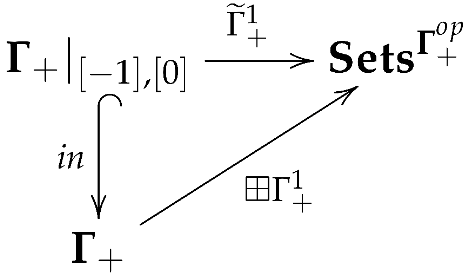

given as
Moreover, is, up to isomorphism, the unique -monoidal extension.
Remark 24.
If we consider , then we have that
Observe that for ,
Then, we have that for . In general, for , we have:
Therefore, for any ,
6.3. Functors of Categorical Semi-Rings Induced by the Dunce Cup
We can construct functors of categorical semi-rings using triangular products:
Corollary 12.
The dunce cup induces the functor of categorical semi-rings:
such that, if
In particular, for every , we have the canonical isomorphism:
Proof.
This is just a consequence of Corollaries 6 and 11. □
Remark 25.
Observe that we can compute the sequential cardinal by means of the matricial product
Corollary 13.
The dunce cup induces the functor of categorical semi-rings:
Proof.
It suffices to apply Corollary 12, Proposition 12 and Theorem 5. □
Example 1.
For the augmented semi-simplicial sets , , we have the cardinal augmented sequences and . Using the formula , we obtain the sequence
Now, using the formula , one has the sequences
On another note, one can check that computing the join of augmented sequences , , we also have:
We point out that , where is the notation used in the encyclopedia of integer numbers (see [16,39]) to denote the number of points on the surface of a tetrahedron. However, the integer sequence does not appear in this encyclopedia.
7. Conclusions and Future Work
Our main conclusion is that there is a nice relationship between augmented semi-simplicial finite sets and augmented sequences of integers. The categorical structure of semi-simplicial sets can be enriched with operations induced by finite coproduts, finite products, joins, and actions of some co-semi-simplicial objects and the space of augmented sequences admits some ring structures, and augmented matrices of integers can be used to transform augmented sequences. The sequential cardinal functor can be considered as an algebraization of the geometric objects given by augmented semi-simplicial finite sets into algebraic structures associated with augmented sequences.
In this paper, we have seen how the binomial numbers are connected with the Yoneda embedding and the iteration of the join operation on the final object of the category of semi-simplicial finite sets are connected with triangular numbers.
The authors have a project consisting of analyzing more properties of this algebraization process; in particular, we can see how the subdivision and the cylinder construction for semi-simplicial sets can be obtained by taking some actions of adequate co-semi-simplical objects and how the sequential cardinal of a subdivision can be computed using chain-power numbers and Stirling numbers (see [14,40]).
A different interesting objective will be to construct a categorical semi-ring (or symmetric bimonoidal category structure)
verifying the following properties:
- If and are finite, then
- If , then
Author Contributions
Investigation, J.M.G.-C., L.J.H.-P. and M.T.R.-R. All authors have contributed equally in this research paper. All authors have read and agreed to the published version of the manuscript.
Funding
This research has been funded by the project PID2020-118753GB-I00 of the Spanish Ministerio de Ciencia e Innovación, the University of La Rioja, and the University of La Laguna.
Institutional Review Board Statement
Not applicable.
Informed Consent Statement
Not applicable.
Data Availability Statement
Data are contained within the article.
Conflicts of Interest
The authors declare no conflict of interest.
References
- Eilenberg, S.; Zilber, J.A. Semi-Simplicial Complexes and Singular Homology. Ann. Math. 1950, 51, 499–513. [Google Scholar] [CrossRef]
- Buoncristiano, C.R.S.; Sanderson, B.J. A Geometric Approach to Homology Theory; London Mathematical Society Lecture Note Series; Cambridge University Press: Cambridge, UK, 1976; Volume 18. [Google Scholar]
- Friedman, G. Survey Article: An elementary illustrated introduction to simplicial sets. Rocky Mt. J. Math. 2012, 42, 353–423. [Google Scholar] [CrossRef]
- Verity, D. Weak complicial sets, a simplicial weak omega-category theory. Part I: Basic homotopy theory. arXiv 2006, arXiv:math/0604414v3. [Google Scholar]
- CooperativeWork. Collaborative nLab: Semi-Simplicial Object. Available online: https://ncatlab.org/nlab/history/semi-simplicial (accessed on 23 December 2021).
- Ebert, J.; Randal-Williams, O. Semisimplicial spaces. Algebr. Geom. Topol. 2019, 19, 2099–2150. [Google Scholar] [CrossRef]
- Gabriel, M.Z.P. Calculus of Fractions and Homotopy Theory; Springer: Berlin/Heidelberg, Germany, 1995. [Google Scholar]
- Graham, R.L.; Knuth, D.E.; Patashnik, O. Concrete Mathematics; Addison-Wesley: Boston, MA, USA, 1990. [Google Scholar]
- Greene, D.H.; Knuth, D.E. Mathematics for the Analysis of Algorithms, 3rd ed.; Birkhäuser: Boston, MA, USA, 1990. [Google Scholar]
- Donaghey, R. Binomial self-inverse sequences and tangent coefficients. J. Comb. Theory Ser. A 1976, 21, 155–163. [Google Scholar] [CrossRef][Green Version]
- Donaghey, R.; Shapiro, L.W. Motzkin numbers. J. Comb. Theory Ser. A 1977, 23, 291–301. [Google Scholar] [CrossRef]
- Riordan, J. Combinatorial Identities; Wiley: New York, NY, USA, 1968. [Google Scholar]
- Kim, H.K. On Regular Polytope Numbers. Proc. Am. Math. Soc. 2003, 131, 65–75. [Google Scholar] [CrossRef]
- Comtet, L. Advanced Combinatorics: The Art of Finite and Infinite Expansion; D. Reidel Pub. Co.: Dordrecht, The Netherlands; Boston, MA, USA, 1974. [Google Scholar]
- Nelsen, R.B.; Schmidt, H. Chains in Power Sets. Math. Mag. 1991, 64, 23–31. [Google Scholar] [CrossRef]
- Sloane, N.J.A.; Plouffe, S. The Encyclopedia of Integer Sequences; Academic Press: Cambridge, MA, USA, 1995. [Google Scholar]
- Biggs, N.L. Discrete Mathematics; Clarendon Press: Oxford, UK, 1985. [Google Scholar]
- Ehlers, P.; Porter, T. Joins for (augmented) simplicial sets. J. Pure Appl. Algebra 2000, 145, 37–44. [Google Scholar] [CrossRef]
- Johnson, N.; Yau, D. Bimonoidal Categories, En-Monoidal Categories, and Algebraic K-Theory. arXiv 2021, arXiv:2107.10526. [Google Scholar]
- Elgueta, J. The groupoid of finite sets is biinitial in the 2-category of rig categories. J. Pure Appl. Algebra 2021, 225, 106738. [Google Scholar] [CrossRef]
- Yau, D. 2Dimensional Categories; Oxford University Press: Oxford, UK, 2021. [Google Scholar]
- Björner, A. Face Number of Complexes and Polytopes. In Proceedings of the International Congress Mathematicians, Berkeley, CA, USA, 3–11 August 1986. [Google Scholar]
- Codenotti, G.; Katthän, L.; Sanyal, R. On f- and h-vectors of relative simplicial complexes. Algebr. Comb. 2019, 2, 343–353. [Google Scholar] [CrossRef]
- Athanasiadis, C.A. Face numbers of uniform triangulations of simplicial complexes. arXiv 2021, arXiv:2003.13372. [Google Scholar] [CrossRef]
- Nevo, E. Complexity yardsticks for f-vectors of polytopes and spheres. arXiv 2019, arXiv:1908.09628. [Google Scholar] [CrossRef]
- Lane, S.M.; Moerdijk, I. Sheaves in Geometry and Logic: A First Introduction to Topos Theory; Springer: New York, NY, USA, 1992. [Google Scholar]
- Laplaza, M. Coherence for distributivity. In Coherence in Categories; Lecture Notes in Mathematics; Kelly, G., Laplaza, M., Lewis, G., Lane, S.M., Eds.; Springer: Berlin/Heidelberg, Germany, 1972; Volume 281, pp. 29–65. [Google Scholar]
- Laplaza, M. A new result of coherence for distributivity. In Coherence in Categories; Lecture Notes in Mathematics; Kelly, G., Laplaza, M., Lewis, G., Lane, S.M., Eds.; Springer: Berlin/Heidelberg, Germany, 1972; Volume 281, pp. 214–235. [Google Scholar]
- Joyal, A.; Street, R. Braided Tensor Categories. Adv. Math. 1993, 102, 20–78. [Google Scholar] [CrossRef]
- MacLane, S. Categories for the Working Mathematician; Graduate Texts in Mathematics; Springer: New York, NY, USA, 1971; Volume 5, pp. i–ix, 1–262. [Google Scholar]
- Kelly, G.M. Basic Concepts of Enriched Category Theory. Repr. Theory Appl. Categ. 2005, 14, 1–18. [Google Scholar]
- Carrasco, P.; Cegarra, A.; Garzón, A. Classifying spaces for braided monoidal categories and lax diagrams of bicategories. Adv. Math. 2021, 226, 419–483. [Google Scholar] [CrossRef]
- Cegarra, A.M. Nonabelian cocycles and the spectrum of a symmetric monoidal category. Turk. J. Math. 2020, 44, 50–84. [Google Scholar] [CrossRef]
- Kong, L.; Yuan, W.; Zhang, Z.H.; Zheng, H. Enriched monoidal categories I: Centers. arXiv 2021, arXiv:2104.03121. [Google Scholar]
- Dell, Z. A Characterization of Braided Enriched Monoidal Categories. arXiv 2021, arXiv:2104.07747. [Google Scholar]
- Trujillo, L. A Coherent Proof of Mac Lane’s Coherence Theorem. Bachelor’s Thesis, Harvey Mudd College, Claremont, CA, USA, 2020. [Google Scholar]
- CooperativeWork. Collaborative Wiki nLab: Day Convolution. 2020. Available online: https://ncatlab.org/nlab/show/Day+convolution (accessed on 23 December 2021).
- Milewski, B. Free Monoidal Functors. 2018. Available online: https://bartoszmilewski.com/2018/05/16/free-monoidal-functors-categorically/ (accessed on 23 December 2021).
- CooperativeWork. The Online Encyclopedia of Integer Sequences. 2021. Available online: https://oeis.org (accessed on 23 December 2021).
- Schader, M. Hierarchical Analysis: Classification with Ordinal Object Dissimilarities. Metrika 1980, 27, 127–132. [Google Scholar] [CrossRef]
Publisher’s Note: MDPI stays neutral with regard to jurisdictional claims in published maps and institutional affiliations. |
© 2022 by the authors. Licensee MDPI, Basel, Switzerland. This article is an open access article distributed under the terms and conditions of the Creative Commons Attribution (CC BY) license (https://creativecommons.org/licenses/by/4.0/).